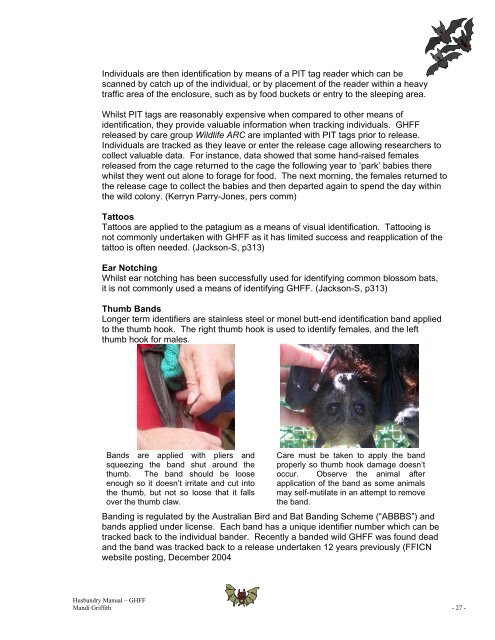Husbandry Manual for Grey- Headed Flying Fox - Nswfmpa.org
Husbandry Manual for Grey- Headed Flying Fox - Nswfmpa.org
Husbandry Manual for Grey- Headed Flying Fox - Nswfmpa.org
Create successful ePaper yourself
Turn your PDF publications into a flip-book with our unique Google optimized e-Paper software.
Individuals are then identification by means of a PIT tag reader which can be<br />
scanned by catch up of the individual, or by placement of the reader within a heavy<br />
traffic area of the enclosure, such as by food buckets or entry to the sleeping area.<br />
Whilst PIT tags are reasonably expensive when compared to other means of<br />
identification, they provide valuable in<strong>for</strong>mation when tracking individuals. GHFF<br />
released by care group Wildlife ARC are implanted with PIT tags prior to release.<br />
Individuals are tracked as they leave or enter the release cage allowing researchers to<br />
collect valuable data. For instance, data showed that some hand-raised females<br />
released from the cage returned to the cage the following year to ‘park’ babies there<br />
whilst they went out alone to <strong>for</strong>age <strong>for</strong> food. The next morning, the females returned to<br />
the release cage to collect the babies and then departed again to spend the day within<br />
the wild colony. (Kerryn Parry-Jones, pers comm)<br />
Tattoos<br />
Tattoos are applied to the patagium as a means of visual identification. Tattooing is<br />
not commonly undertaken with GHFF as it has limited success and reapplication of the<br />
tattoo is often needed. (Jackson-S, p313)<br />
Ear Notching<br />
Whilst ear notching has been successfully used <strong>for</strong> identifying common blossom bats,<br />
it is not commonly used a means of identifying GHFF. (Jackson-S, p313)<br />
Thumb Bands<br />
Longer term identifiers are stainless steel or monel butt-end identification band applied<br />
to the thumb hook. The right thumb hook is used to identify females, and the left<br />
thumb hook <strong>for</strong> males.<br />
Bands are applied with pliers and<br />
squeezing the band shut around the<br />
thumb. The band should be loose<br />
enough so it doesn’t irritate and cut into<br />
the thumb, but not so loose that it falls<br />
over the thumb claw.<br />
Care must be taken to apply the band<br />
properly so thumb hook damage doesn’t<br />
occur. Observe the animal after<br />
application of the band as some animals<br />
may self-mutilate in an attempt to remove<br />
the band.<br />
Banding is regulated by the Australian Bird and Bat Banding Scheme (“ABBBS”) and<br />
bands applied under license. Each band has a unique identifier number which can be<br />
tracked back to the individual bander. Recently a banded wild GHFF was found dead<br />
and the band was tracked back to a release undertaken 12 years previously (FFICN<br />
website posting, December 2004<br />
<strong>Husbandry</strong> <strong>Manual</strong> – GHFF<br />
Mandi Griffith - 27 -

















